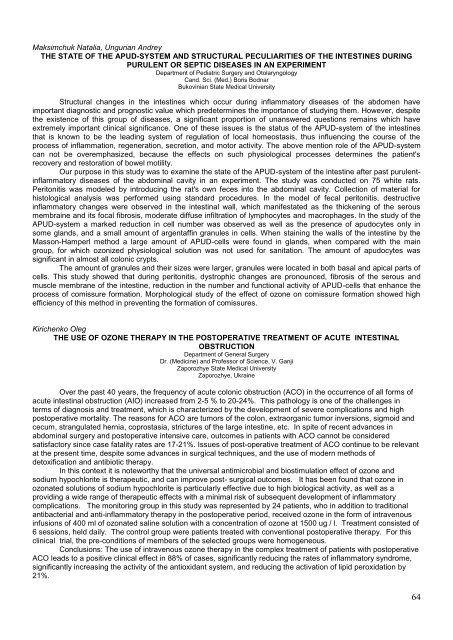ÐбÑÑник Ñез XVI ÐÑжнаÑодно медиÑного конгÑеÑÑ ÑÑÑденÑÑв Ñа ...
ÐбÑÑник Ñез XVI ÐÑжнаÑодно медиÑного конгÑеÑÑ ÑÑÑденÑÑв Ñа ...
ÐбÑÑник Ñез XVI ÐÑжнаÑодно медиÑного конгÑеÑÑ ÑÑÑденÑÑв Ñа ...
You also want an ePaper? Increase the reach of your titles
YUMPU automatically turns print PDFs into web optimized ePapers that Google loves.
Maksimchuk Natalia, Ungurian Andrey<br />
THE STATE OF THE APUD-SYSTEM AND STRUCTURAL PECULIARITIES OF THE INTESTINES DURING<br />
PURULENT OR SEPTIC DISEASES IN AN EXPERIMENT<br />
Department of Pediatric Surgery and Otolaryngology<br />
Cand. Sci. (Med.) Boris Bodnar<br />
Bukovinian State Medical University<br />
Structural changes in the intestines which occur during inflammatory diseases of the abdomen have<br />
important diagnostic and prognostic value which predetermines the importance of studying them. However, despite<br />
the existence of this group of diseases, a significant proportion of unanswered questions remains which have<br />
extremely important clinical significance. One of these issues is the status of the APUD-system of the intestines<br />
that is known to be the leading system of regulation of local homeostasis, thus influencing the course of the<br />
process of inflammation, regeneration, secretion, and motor activity. The above mention role of the APUD-system<br />
can not be overemphasized, because the effects on such physiological processes determines the patient's<br />
recovery and restoration of bowel motility.<br />
Our purpose in this study was to examine the state of the APUD-system of the intestine after past purulentinflammatory<br />
diseases of the abdominal cavity in an experiment. The study was conducted on 75 white rats.<br />
Peritonitis was modeled by introducing the rat's own feces into the abdominal cavity. Collection of material for<br />
histological analysis was performed using standard procedures. In the model of fecal peritonitis, destructive<br />
inflammatory changes were observed in the intestinal wall, which manifestated as the thickening of the serous<br />
membraine and its focal fibrosis, moderate diffuse infiltration of lymphocytes and macrophages. In the study of the<br />
APUD-system a marked reduction in cell number was observed as well as the presence of apudocytes only in<br />
some glands, and a small amount of argentaffin granules in cells. When staining the walls of the intestine by the<br />
Masson-Hamperl method a large amount of APUD-cells were found in glands, when compared with the main<br />
group, for which ozonized physiological solution was not used for sanitation. The amount of apudocytes was<br />
significant in almost all colonic crypts.<br />
The amount of granules and their sizes were larger, granules were located in both basal and apical parts of<br />
cells. This study showed that during peritonitis, dystrophic changes are pronounced, fibrosis of the serous and<br />
muscle membrane of the intestine, reduction in the number and functional activity of APUD-cells that enhance the<br />
process of comissure formation. Morphological study of the effect of ozone on comissure formation showed high<br />
efficiency of this method in preventing the formation of comissures.<br />
Kirichenko Oleg<br />
THE USE OF OZONE THERAPY IN THE POSTOPERATIVE TREATMENT OF ACUTE INTESTINAL<br />
OBSTRUCTION<br />
Department of General Surgery<br />
Dr. (Medicine) and Professor of Science, V. Ganji<br />
Zaporozhye State Medical University<br />
Zaporozhye, Ukraine<br />
Over the past 40 years, the frequency of acute colonic obstruction (ACO) in the occurrence of all forms of<br />
acute intestinal obstruction (AIO) increased from 2-5 % to 20-24%. This pathology is one of the challenges in<br />
terms of diagnosis and treatment, which is characterized by the development of severe complications and high<br />
postoperative mortality. The reasons for ACO are tumors of the colon, extraorganic tumor inversions, sigmoid and<br />
cecum, strangulated hernia, coprostasia, strictures of the large intestine, etc. In spite of recent advances in<br />
abdominal surgery and postoperative intensive care, outcomes in patients with ACO cannot be considered<br />
satisfactory since case fatality rates are 17-21%. Issues of post-operative treatment of ACO continue to be relevant<br />
at the present time, despite some advances in surgical techniques, and the use of modern methods of<br />
detoxification and antibiotic therapy.<br />
In this context it is noteworthy that the universal antimicrobial and biostimulation effect of ozone and<br />
sodium hypochlorite is therapeutic, and can improve post- surgical outcomes. It has been found that ozone in<br />
ozonated solutions of sodium hypochlorite is particularly effective due to high biological activity, as well as a<br />
providing a wide range of therapeutic effects with a minimal risk of subsequent development of inflammatory<br />
complications. The monitoring group in this study was represented by 24 patients, who in addition to traditional<br />
antibacterial and anti-inflammatory therapy in the postoperative period, received ozone in the form of intravenous<br />
infusions of 400 ml of ozonated saline solution with a concentration of ozone at 1500 ug / l. Treatment consisted of<br />
6 sessions, held daily. The control group were patients treated with conventional postoperative therapy. For this<br />
clinical trial, the pre-conditions of members of the selected groups were homogeneous.<br />
Conclusions: The use of intravenous ozone therapy in the complex treatment of patients with postoperative<br />
ACO leads to a positive clinical effect in 88% of cases, significantly reducing the rates of inflammatory syndrome,<br />
significantly increasing the activity of the antioxidant system, and reducing the activation of lipid peroxidation by<br />
21%.<br />
64
















